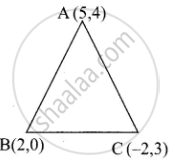Advertisements
Advertisements
Question
Show that the following points taken in order to form an isosceles triangle
A(5, 4), B(2, 0), C(−2, 3)
Solution

Distance = `sqrt((x_2 - x_1)^2 + (y_2 - y_1)^2`
AB = `sqrt((2 - 5)^2 + (0 - 4)^2`
= `sqrt((- 3)^2 + (- 4)^2`
= `sqrt(9 + 16)`
= `sqrt(25)`
= 5
BC = `sqrt((-2 - 2)^2 + (3 - 0)^2`
= `sqrt((-4)^2 + (3)^2`
= `sqrt(16 + 9)`
= `sqrt(25)`
= 5
AC = `sqrt((-2 - 5)^2 + (3 - 4)^2`
= `sqrt((-7)^2 + (-1)^2`
= `sqrt(49 + 1)`
= `sqrt(50)`
= `sqrt(25 xx 2)`
= `5sqrt(2)`
AB = BC = 5 ...(Two sides are equal)
∴ ABC is an isosceles triangle.
APPEARS IN
RELATED QUESTIONS
If the co-ordinate of A is x and that of B is y, find d(A, B).
x = 6, y = - 2
If the co-ordinate of A is x and that of B is y, find d(A, B).
x = - 3, y = 7
On a number line, co-ordinates of P, Q, R are 3, -5 and 6 respectively. State with reason whether the following statement is true or false.
d(P, Q) + d(Q, R) = d(P, R)
Co-ordinates of the pair of a point is given below. Hence find the distance between the pair.
3, 6
Co-ordinates of the pair of points are given below. Hence find the distance between the pair.
80, - 85
Co-ordinate of point P on a number line is - 7. Find the co-ordinates of points on the number line which are at a distance of 8 units from point P.
Show that the following points taken in order to form an equilateral triangle
`"A"(2, 2), "B"(-2, -2), "C"(-2sqrt(3), 2sqrt(3))`
Show that the following points taken in order to form the vertices of a parallelogram
A(−7, −3), B(5, 10), C(15, 8) and D(3, −5)
A(−1, 1), B(1, 3) and C(3, a) are point and if AB = BC, then find ‘a’
The point (x, y) is equidistant from the points (3, 4) and (−5, 6). Find a relation between x and y
